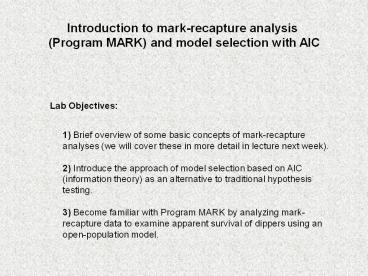Introduction to mark-recapture analysis - PowerPoint PPT Presentation
1 / 21
Title:
Introduction to mark-recapture analysis
Description:
1) Brief overview of some basic concepts of mark-recapture analyses (we will ... data to examine apparent survival of male dippers using an open-population model. ... – PowerPoint PPT presentation
Number of Views:396
Avg rating:3.0/5.0
Title: Introduction to mark-recapture analysis
1
Introduction to mark-recapture analysis (Program
MARK) and model selection with AIC
Lab Objectives
- 1) Brief overview of some basic concepts of
mark-recapture analyses (we will cover these in
more detail in lecture next week). - 2) Introduce the approach of model selection
based on AIC (information theory) as an
alternative to traditional hypothesis testing. - 3) Become familiar with Program MARK by analyzing
mark-recapture data to examine apparent survival
of dippers using an open-population model.
2
Useful references for beginners (and others)
Amstrup, SC, TL McDonald, and BFJ Manley (eds.).
2005. Handbook of capture-recapture analysis.
Princeton University Press.
Cooch, E. and G. White (eds.). Program MARK a
gentle introduction. 9th edition. Available for
downloading from http//www.phidot.org/software/ma
rk/docs/book/
3
Background on Todays Exercise
- Use Cormack-Jolly-Seber model to estimate
apparent survival - Based on live recaptures for an open population
- Apparent survival (f) emigration is counted as
mortality - Thus, apparent survival is often less than true
survival (S) - We will need to estimate two parameters
- apparent survival
- capture probability
4
Creating encounter histories
Records of marking and recapture
Encounter history for animal 1147-38951
5
Basic types of encounter histories
Summary encounter history (four individuals have
same history)
Individual encounter histories
- Must use this form if you want to add individual
covariates
6
Encounter history for two groups (e.g., sexes)
23 males, 17 females
7
Summary encounter history (4 males, 2 females)
Individual encounter history with dummy coding to
indicate sex
1 0 male 0 1 female
8
Encounter histories with individual covariates
Age, condition, wing length, body length
9
Interpretation of encounter histories (in words)
10
fi is probability of surviving from time (i) to
(i t)
pi is probability of encounter at time (i) given
that individual is alive and in sample
So (1-P) is the probability of not detecting
individual that is in area
11
Interpretation of encounter histories (using
probabilities)
12
General idea is to use maximum likelihood (ML)
approach to derive estimates of f and P that
maximizes the likelihood of observing the
frequency of individuals with particular
encounter histories.
That is, we want to find the most likely
estimates of f and P given the observed
encountered histories.
13
Indexing convention used by MARK
14
Individual can be first marked at different time
periods
15
Selection of models using AIC
- Akaike Information Criterion (AIC)
- Approach for ranking statistical models from best
to worst - Alternative to traditional hypothesis-testing
procedures - No P-values and we do not worry about
statistical significance - Becoming widely used in ecology and wildlife
biology
Burnham KP Anderson DR. 1998. Model selection
and multimodel inference a practical
information-theoretic approach. 2nd edition.
Springer.
16
AIC-based model selection in a nutshell
1. Develop candidate set of statistical models
based on biological insights. These models
represent your multiple, alternative hypotheses.
2. Calculate AIC value for each model, and then
rank models based on AIC.
3. AIC values are based on model fit (how well
the observed data fit the model) and the
principle of parsimony (simple models are better,
so there is a penalty for added parameters).
4. If one model is clearly the best, then use it.
If several models are competitive (similar AIC
values), then examine models closely to determine
which variables are really important (cross-model
inference).
17
(-2 times log likelihood)
Model fit
Penalty where K is the number of estimable
parameters
(Program MARK uses a version of AIC that is
adjusted for small sample sizes)
18
?AIC (delta AIC)
?AIC AIC for a model minus the lowest AIC for
any model in set Just a way to rescale
values. ?AIC 0 for the best model
19
An example from Schooley and Wiens (2003)
20
Example Do rabbits eat voles? (Oliver et al.)
21
Model Comparison































